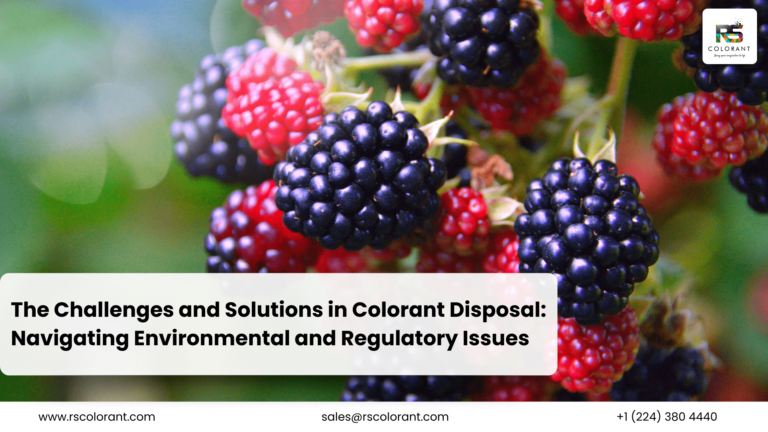Colorants in Product Identification – Introduction
Colorants play a significant role in our daily lives, influencing everything from the food we eat to the clothes we wear. They are crucial in product identification, helping consumers make choices quickly and efficiently. Whether it’s the bright red of a soft drink can or the soothing blue of a skincare product, colors help products stand out and communicate their purpose and appeal.
What Are Colorants?
Colorants are substances that impart color to a material or mixture. They can be classified into two main types: dyes and pigments. Dyes are soluble and are used to color fabrics, food, and cosmetics, while pigments are insoluble and are commonly used in paints, inks, and plastics.
Natural vs. Synthetic Colorants
Natural colorants are derived from plants, minerals, or animals, such as beet juice or turmeric. Synthetic colorants, on the other hand, are man-made and often provide more vibrant and stable colors. Both types have their own set of advantages and disadvantages, including cost, stability, and potential health effects.
Historical Use of Colorants
Colorants have been used since ancient times for a variety of purposes. Early humans used natural materials like ochre and charcoal to create cave paintings. As civilizations advanced, they discovered more sophisticated methods for producing dyes and pigments, leading to the rich tapestry of colors we see today.
Colorants in Food Products
In the food industry, colorants are essential for making products appealing and easily identifiable. For example, the yellow color of butter indicates its freshness and quality. However, the use of colorants in food is heavily regulated to ensure safety. Organizations like the FDA and EFSA set strict guidelines on which colorants can be used and in what quantities.
Colorants in Cosmetics
Cosmetics rely heavily on colorants for both aesthetic and branding purposes. The right shade of lipstick or eyeshadow can define a brand’s image and attract consumers. Regulatory bodies like the FDA also oversee the use of colorants in cosmetics to ensure they are safe for human use.
Colorants in Pharmaceuticals
Colorants help differentiate between various medications, reducing the risk of errors. For instance, different colors can indicate different dosages or types of medication, making it easier for both healthcare providers and patients to identify them correctly. Safety regulations ensure that these colorants do not affect the efficacy or safety of the drugs.
Colorants in Textiles
The textile industry uses colorants to create a vast array of clothing and fabric options. Advances in dyeing technology have allowed for more vibrant and long-lasting colors. This not only appeals to consumers but also plays a role in fashion trends and personal expression.
Colorants in Packaging
Packaging is another area where colorants are crucial. They help in brand recognition and convey information about the product inside. For example, eco-friendly products often use green packaging to communicate their environmental benefits. However, the environmental impact of packaging colorants is a growing concern, leading to a push for more sustainable options.
Technological Advances in Colorants
Recent technological advancements have led to the development of new colorants that are more stable, vibrant, and environmentally friendly. Innovations such as nanotechnology and biotechnologically produced colorants are paving the way for future trends in the industry.
Color Psychology
The psychology of color is a fascinating field that explores how different colors affect human behavior and decision-making. For instance, red can create a sense of urgency, making it effective for clearance sales, while blue can induce a sense of calm, suitable for healthcare products.
Environmental Impact of Colorants
The production and disposal of colorants can have significant environmental impacts. Many synthetic colorants are derived from petroleum, a non-renewable resource, and can be harmful if not disposed of properly. As a result, there is a growing interest in eco-friendly colorants made from sustainable materials.
Safety and Regulatory Issues
The safety of colorants is a critical concern, with global regulations in place to protect consumers. These regulations vary by region but generally aim to ensure that colorants do not pose health risks. Regular testing and compliance with these regulations are essential for manufacturers.
Case Studies
Numerous case studies highlight the successful use of colorants in various industries. For example, the rebranding of a major beverage company with a new color scheme resulted in a significant increase in sales. Such examples demonstrate the powerful impact of color on consumer behavior.
Challenges and Controversies
Despite their benefits, colorants also face challenges and controversies. Synthetic colorants, in particular, have been linked to health concerns, leading to increased demand for natural alternatives. Additionally, consumer perceptions of colorants can vary, affecting market trends.
Conclusion
Colorants are integral to product identification, influencing consumer choices and brand perception. While there are challenges and controversies, advancements in technology and a shift towards sustainability offer promising solutions for the future.
FAQs
- What are the main types of colorants used in products?
- The main types are dyes and pigments, with dyes being soluble and used in items like fabrics and cosmetics, while pigments are insoluble and used in paints and plastics.
- Are natural colorants safer than synthetic ones?
- Both have their pros and cons. Natural colorants are perceived as safer by some, but synthetic colorants often provide more consistent results and stability.
- How are colorants regulated in the food industry?
- Organizations like the FDA and EFSA set strict guidelines on which colorants can be used in food and in what quantities to ensure consumer safety.
- Why are colorants important in pharmaceuticals?
- They help differentiate between medications, reducing the risk of errors and making it easier for healthcare providers and patients to identify them correctly.
- What are the environmental impacts of colorants?
- The production and disposal of synthetic colorants can be harmful to the environment, leading to a growing interest in eco-friendly alternatives made from sustainable materials.




